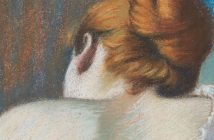The Fine Art Society, as its name suggests, would not you would think welcome, let alone attract, a Turner prize winner. The controversial and oft lambasted art prize has ruffled a few feathers among established and more, shall we say, refined critics in its time. So if ever there were a former Turner winner to whom it might open its doors and permit a showcase of contemporary art, who better than the man who was perhaps the most universally well-liked among the public, his competitors and the critics alike; the winner from 2004, Jeremy Deller.
But it’s the nature of the show in question that makes the Fine Art Society a natural fit. Deller has brought together works from eight contemporary artists with modern British forebears who have inspired or fascinated them. ‘‘Artists are art lovers’, Deller explains, “and it’s nice to give my contemporaries’ work an airing alongside artists we’ve all looked at since adolescence – I’m interested to see friends and contemporaries alongside them.”
And Deller’s selection is every bit as eminent as their influences. Among those exhibiting are Peter Doig, who’s White Canoe set an auction record for a living European artist when it sold for $11.3million at Sotheby’s in 2007; Paul Noble, who in 1988 turned a redundant betting shop into one of the most influential artist-run spaces in London; and the controversy-courting and fellow Turner winner Chris Ofili, who’s Black Madonna exhibited at the Brooklyn Museum of Art in 1999 became the subject of a lawsuit between them and the then mayor of NYC, Rudi Giuliani. The other artists in the line-up are Tasha Amini, Steven Claydon, Stephen Fowler, Ed Hall and Nick Pankhurst.
This adventurous eight will be shown with works by Edward Bawden, Edward Burra, Richard Dadd, Morris & Co, Eduardo Paolozzi, John Piper, Eric Ravilious, Walter Sickert and Christopher Wood. The selection is pertinent and reflected in Deller’s chosen title for the show, The Strawberry Thief, from a design by William Morris, since it reflects the idea that each artist – to continue the fruit metaphor – has been cherry-picked specifically and, in turn, ‘stolen’ a motif or idea to produce the dedication.
Many of the artists have produced works specifically for the exhibition; Ravilious particularly has been homaged with a surreal wooden plant house constructed in the form of a church from his previously unrealised design. I can’t say by whom, however, since, interestingly, not all of the contemporary artists’ works are named, giving the exhibition a certain intrigue as one attempts to work out who’s paired with whom.
Far from being a departure from its traditional ethos, this element of non-conformity is, in fact, key to the Society’s principles. Contrary to one’s assumptions, the Fine Art Society is not, as its name suggests, an elitist, archaic institution. Connoisseurship it hails, certainly, but in its 140 year history it has developed a rich tradition of innovation, even and often championing unfairly neglected artists. It is this heritage that makes such an exhibition an ideal fit. “It’s a gallery where you never know what you’re going to see,” says Deller, “there’s always something surprising, unusual or lovely to find there…”
The Strawberry Thief runs at The Fine Art Society, 148 New Bond Street, London W1 until 28th October. For more information visit the website.




